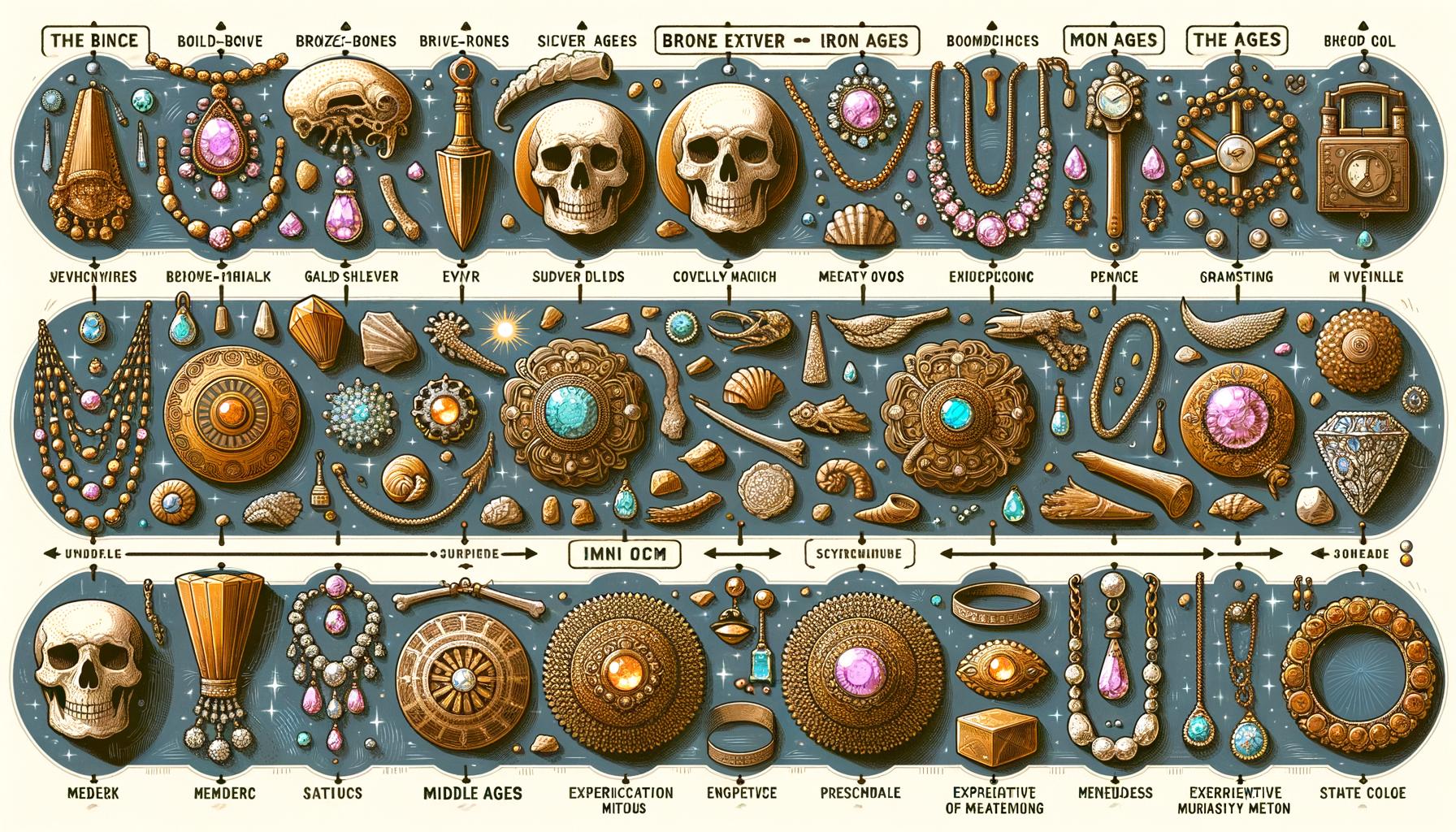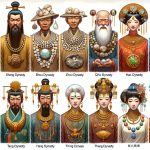The history and evolution of jewelry materials is a fascinating journey that speaks volumes about human creativity, social structures, and technological advancements. Jewelry, an essential form of human expression, has adorned the bodies of men and women for thousands of years, often serving as indicators of status, wealth, culture, and personal or communal identity.
From the earliest humans who used bones and shells to modern artisans crafting intricate pieces using sustainable materials, the story of jewelry materials is rich with innovation and cultural significance.
Understanding the journey of materials used in jewelry making allows us to appreciate not just the aesthetic beauty of these adornments but also their cultural and historical contexts. The transition from rudimentary ornaments made from natural elements like bones and stones to sophisticated pieces fashioned from precious metals like gold and silver marks significant evolutionary stages in human society. This progression reflects our evolving relationship with our environment and highlights key advances in technology and craftsmanship.
By delving into the various epochs-from ancient civilizations utilizing organic materials to the rise of gemstones coveted for their rarity-one can trace how different societies have valued specific resources over time. This exploration reveals more than mere trends; it uncovers layers of meaning that these materials held within diverse cultures.
Whether it’s through ancient accents like jade in China or diamonds in modern jewelry design, each era presents its own unique narrative woven through the substances chosen for ornamentation.
Ancient Beginnings
Primitive Adornments
Jewelry’s origins trace back to primitive societies where adornment was both a practical and symbolic practice. Early humans utilized what was readily available in their environment, crafting jewelry out of bones, shells, and stones.
These materials were fashioned into necklaces, bracelets, and amulets, often serving as symbols of power or status within the community. The discovery of ancient burial sites reveals that these early adornments were also used in rituals, suggesting a deep-seated human need to express identity and beliefs through personal decoration.
Materials Across Cultures
As we explore the history and evolution of jewelry materials, we see distinct choices emerging from different ancient cultures. In the Neolithic period, humans began polishing stones to create more refined pieces. Mesopotamian artifacts reveal intricate designs made from lapis lazuli imported from what is now Afghanistan.
Meanwhile, Ancient Egyptians are renowned for their use of gold complemented by colorful stones like turquoise and carnelian. Each culture selected materials that either held local significance or were obtainable through early trade networks.
Symbolism and Sacred Uses
The symbolism attached to these early jewelry materials varied but often carried significant meaning. Bones might be worn as talismans for protection or hunting success, while seashells collected from specific locations could signify journeys or connections to distant lands.
In many cases, particular stones and minerals were believed to possess spiritual qualities; for instance, Ancient Egyptians associated the blue color of lapis lazuli with the heavens and divine favor. Thus, beyond their aesthetic qualities, these early jewelry pieces played integral roles in social rituals and spiritual practices.
Precious Metals
The discovery and utilization of gold and silver marked a transformative period in the history and evolution of jewelry materials. In ancient civilizations such as Egypt, Mesopotamia, and Greece, gold was not just a metal but a symbol of divine beauty and eternal brilliance. These precious metals were highly prized for their luster, rarity, and malleability.
The Pharaohs of Ancient Egypt adorned themselves with intricate gold jewelry that signified their divine right to rule. Similarly, in Mesopotamia, gold and silver artifacts have been unearthed from royal tombs, underscoring the importance that these cultures placed on these gleaming metals.
Gold and silver quickly became the preferred materials for royalty and the elite due to their aesthetic appeal and perceived supernatural properties. Gold’s resistance to tarnish made it an enduring symbol of wealth and power. This association with permanence was symbolic in many ancient cultures where rulers desired to be remembered for eternity.
Silver, albeit less prestigious than gold, found favor among the noble classes for its reflective quality and relative affordability compared to its yellow counterpart. Both metals were often alloyed with other elements to enhance their strength while maintaining workability.
Revolutionary techniques such as smelting and alloying significantly advanced the craft of jewelry making during this era. Smelting allowed artisans to extract pure metal from ores efficiently, while alloying enabled them to create stronger items by mixing metals like copper with gold (creating rose gold) or adding elements like zinc to silver (producing sterling silver).
These innovations not only made jewelry more accessible but also expanded the possibilities for design complexity. Goldsmiths developed sophisticated methods such as granulation-attaching tiny spheres onto surfaces-to create elaborate patterns that showcased their unparalleled craftsmanship.
In summary, the ascendance of gold and silver as coveted materials ushered in an epoch where jewelry transcended mere adornment to become symbols laden with cultural significance. Through advanced metallurgical techniques, artisans were able to push the boundaries of what was possible in jewelry creation, laying down a legacy that continues to shape contemporary practices.
Gemstones
The allure of gemstones has captivated human civilizations for millennia, drawing them towards these stunning natural marvels hidden within the Earth’s crust. The history and evolution of jewelry materials is incomplete without delving into the precious gems that have adorned royal crowns, religious artifacts, and personal ornaments across ages. Diamonds, emeralds, sapphires, and rubies are among the most revered gemstones, each with its unique set of tales and cultural significance.
Historical Value and Significance
Diamonds were first discovered in India over 2,000 years ago and quickly became symbols of strength and invincibility due to their unparalleled hardness. Emeralds, known for their vibrant green hue, were mined in Ancient Egypt as early as 1500 BCE.
These gems were believed to bring fertility and eternal youth to their wearers. Similarly, rubies held a particular fascination in Southeast Asia and were often considered more valuable than diamonds because of their striking red color symbolizing power and passion.
Mining and Trade Routes
The global appreciation of gemstones can be traced through historical trade routes that facilitated the exchange of these treasures between distant lands. The Silk Road was instrumental in spreading the allure of gemstones from Asia to Europe. For instance, sapphires from Sri Lanka made their way to Rome, captivating the Western world with their deep blue luster. These trading pathways not only popularized the use of various gemstones but also influenced designs by introducing new cutting techniques and aesthetics.
The Evolution of Cutting and Polishing Techniques
Initially utilized in their rough forms or minimally altered states, gemstones underwent significant evolution with advancements in cutting and polishing techniques. The ancient Greeks are credited with pioneering methods such as flat-polished surfaces around 600-400 BCE.
By the Renaissance period in Europe, gemstone cutting had become a sophisticated art form with numerous distinct cuts like brilliants, cushions, and cabochons emerging to enhance their sparkle and visual appeal further. Modern technology continues to push these boundaries by perfecting laser cutting techniques that allow for unprecedented precision in shaping gemstones.
In summing up this segment on “Gemstones: Nature’s Treasure Trove,” it’s clear how deeply intertwined our civilization’s development is with these precious stones’ discovery, trade, admiration mechanisms behind fashioning them into stunning pieces of adornment-a true testament to humanity’s timeless attraction toward nature’s extraordinary gifts encapsulated within each gemstone.
Cultural Influences
The history and evolution of jewelry materials have been profoundly impacted by cultural influences throughout different periods. Various cultures have introduced unique materials and styles that reflect their societal values, spiritual beliefs, and aesthetic preferences. For instance, Ancient Egypt was one of the earliest civilizations to use gold in jewelry extensively due to its association with immortality and the divine.
Similarly, jade played a significant role in Chinese culture, symbolizing purity, moral integrity, and eternity. The incorporation of such distinct materials not only enriched the diversity of global jewelry traditions but also broadened the spectrum of human expression through adornment.
African cultures have made remarkable contributions to the world of jewelry through their use of locally available materials like ivory, beads, and lacquer. Ivory, harvested from elephant tusks or walrus teeth, was often intricately carved into elaborate designs carrying symbolic meanings or representing social status within tribes.
Beadwork has also been a prominent feature in African jewelry-making; various regions utilized beads made from glass, clay, or wood to create pieces that conveyed identity markers such as ethnicity or social standing. Furthermore, Indian artisans developed techniques for working with both precious stones and metals like gold to produce intricate designs that are still admired today for their craftsmanship and beauty.
The influence of East Asian jewelry traditions cannot be understated either. Japanese lacquerware represents an exquisite blend of natural elegance and technical mastery.
By using sap from native lacquer trees combined with gold dust or other decorative elements, craftsmen created items that were as durable as they were beautiful. Trade routes played a crucial role in diversifying these materials globally; Silk Road trade facilitated the exchange of precious stones between East Asia, Europe, and Africa while maritime routes brought exotic materials like pearls from the South Seas into Western markets.
- Ancient Egypt: Utilization of gold
- China: Jade symbolizing purity
- Africa: Use of ivory and beads
- India: Combination of precious stones
- Japan: Lacquerware techniques
Through these diverse cultural influences on jewelry materials and designs across centuries, we see how deeply interwoven human creativity is with our natural environment. Each culture’s contribution has not only enhanced our understanding but also shaped how modern designers approach their craft today.
The Industrial Revolution
Moreover, new materials were introduced into the world of jewelry during this era. The use of steel became popular due to its strength and versatility. Jewelers started experimenting with aluminum as well, which was valued for its lightweight properties and resistance to tarnish. These innovations not only diversified the types of materials used but also led to new styles and designs that reflected the changing times.
Another significant advancement was in gemstone cutting technology. While traditional methods were still in use, new machinery made it possible to cut gemstones with greater precision and consistency. This industrial progress enabled more intricate designs and higher quality finishes that were previously unattainable. These technological strides significantly influenced the diversification of jewelry materials, pushing the boundaries of what could be achieved through creative expression.
| Technological Advancements | Impact on Jewelry |
|---|---|
| Mass Production | Increased accessibility |
| Electroplating | Broader economic reach |
| New Materials (Steel & Aluminum) | Diversification of styles |
| Advanced Cutting Techniques | Higher quality gemstones |
These advances did not come without challenges or criticisms; some lamented the loss of handcrafted uniqueness in favor of standardized mass production. However, others saw it as an opportunity for artistic innovation since the ability to work with a wider array of materials opened up new horizons for creative expression. As we trace back through the history and evolution of jewelry materials, it’s clear that the Industrial Revolution marks a pivotal point where tradition met innovation in fascinating ways.
Modern and Alternative Materials
The 20th and 21st centuries have witnessed a remarkable transformation in the materials used for jewelry, blending innovation with tradition to cater to evolving tastes and values. One significant development is the rise of alternative materials such as plastics, resin, and titanium. These substances have challenged longstanding norms by introducing new aesthetic possibilities and making high-quality adornment more accessible.
Plastics, for instance, revolutionized costume jewelry in the mid-20th century, offering diverse colors and forms that were previously unattainable. Resin has also gained popularity for its versatility, allowing jewelers to encapsulate various objects or create vibrant pieces with intricate designs.
Eco-friendly and sustainable materials have become increasingly important as global awareness around environmental issues grows. Many contemporary jewelers are now focusing on ethically sourced gemstones, recycled metals, and even organic materials like wood and seeds to create their designs. This shift is partly driven by consumers who are more educated about the impact of their purchases on both people and the planet. Some notable eco-friendly practices include:
- Recycled Metals: Using reclaimed gold, silver, or platinum reduces the need for mining new materials.
- Fair Trade Gemstones: Ensuring that gems are sourced from mines adhering to fair labor practices.
- Biodegradable Materials: Incorporating materials that can return to nature without causing harm.
Technology has also significantly influenced modern jewelry design and material selection. The advent of three-dimensional (3D) printing has opened up new avenues for creativity by enabling designers to produce complex shapes that would be challenging or impossible with traditional methods. Furthermore, lab-grown diamonds have emerged as an environmentally friendly alternative to mined diamonds while maintaining identical physical properties. As technology continues to advance, it brings with it endless possibilities for innovation in jewelry making.
In this ever-evolving landscape, traditional craftsmanship still holds an essential place alongside these modern advancements. Jewelers blend age-old techniques like hand-forging and stone setting with cutting-edge technology to create unique pieces that honor both past traditions and future innovations. This blending truly defines the history and evolution of jewelry materials-a continuous journey where old meets new in captivating harmony.
Contemporary Trends
As we step into the contemporary era, the history and evolution of jewelry materials have taken fascinating turns. One of the standout trends is the growing popularity of lab-grown diamonds.
These diamonds, created through advanced technological processes such as Chemical Vapor Deposition (CVD) or High Pressure High Temperature (HPHT), are virtually indistinguishable from their mined counterparts in terms of physical and chemical properties. What sets them apart is their ethical sourcing, as they eliminate the environmental and social issues often associated with traditional diamond mining.
In addition to lab-grown diamonds, there has been a significant shift toward ethical sourcing and sustainable practices in modern jewelry-making. Consumers today are more conscious than ever about the origins of their products. This has led to a surge in demand for materials that are both eco-friendly and ethically sourced.
For example, recycled metals such as gold and silver are becoming mainstream options for jewelers who wish to minimize their environmental footprint. The use of Fairmined certified precious metals ensures that materials are sourced responsibly, providing better working conditions for miners and reducing ecological damage.
Technology continues to influence jewelry design and material selection drastically. Innovations such as 3D printing have opened up new avenues for creative exploration, allowing designers to craft intricate pieces that were once impossible to achieve through traditional methods. Moreover, materials like bioplastics and eco-resins are emerging on the scene, offering sustainable alternatives without compromising on style or durability.
| Trend | Detail |
|---|---|
| Lab-Grown Diamonds | Created using CVD or HPHT processes; ethical and indistinguishable from mined diamonds. |
| Sustainable Practices | Recycled metals such as gold and silver; Fairmined certifications. |
| Technological Innovations | 3D printing; use of bioplastics and eco-resins in jewelry design. |
Conclusion
Reflecting on the history and evolution of jewelry materials offers a deep appreciation for the artistry and innovation that have shaped human adornment throughout time. From the rudimentary yet meaningful use of bones and shells in ancient societies to the sophisticated goldsmithing techniques of classical civilizations, each era has left an indelible mark on how we perceive and value jewelry today.
The progression from natural materials to refined metals like gold and silver underscores humanity’s relentless pursuit of beauty and status, transforming mere ornaments into powerful symbols of cultural identity and personal expression.
The journey through various cultures reveals not only differences in aesthetic preferences but also shared values across civilizations. Whether it was the jade carvings revered in East Asia or the glittering gemstones traded along ancient routes, these materials did more than just embellish-they communicated stories, beliefs, and social hierarchies.
Innovations like smelting in antiquity or electroplating during the Industrial Revolution further propelled jewelry into new realms, making it accessible to broader portions of society while preserving its allure for the elite.
Today, as we navigate a world increasingly aware of ethical sourcing and sustainability, modern jewelry continues to evolve by embracing alternatives such as lab-grown diamonds and eco-friendly materials. These contemporary trends are not just fleeting fashions but are indicative of a larger shift towards responsible consumption.
As we look forward, it’s clear that the story of jewelry is far from complete; rather, it promises an exciting future where tradition harmonizes with innovation, continually redefining what it means to adorn ourselves in beauty and significance. Through understanding the history and evolution of jewelry materials, we gain insight not only into craftsmanship but also into the enduring human spirit that drives us to create lasting symbols of our existence.
Frequently Asked Questions
How Has Jewelry Evolved Over Time?
Jewelry has seen significant evolution over time, influenced by cultural shifts, technological advancements, and changing aesthetic preferences. From the earliest use of simple natural materials like shells and bones to adorn the body, jewelry has transitioned through various stages including the use of precious metals and gemstones in ancient civilizations such as Egypt and Rome.
The Renaissance period marked an era of intricate designs and craftsmanship, while modern times have embraced a wide variety of styles ranging from minimalistic to avant-garde. Today, jewelry is not just a symbol of wealth or status but also an expression of personal style and identity.
What Is the History of the Beginning of Jewelry Making?
The history of jewelry making dates back thousands of years to ancient civilizations where humans first began to create decorative objects for personal adornment. Archaeological evidence suggests that as far back as 25,000 years ago, people were making primitive jewelry from bone, stone, and teeth.
Ancient Egypt is renowned for its significant contributions to jewelry art with elaborate designs using gold and semi-precious stones believed to have protective properties. The process continued evolving through different periods such as Ancient Greece and Rome where goldsmithing became more sophisticated with detailed engravings and filigree work.
What Is the History of Fabric Jewelry?
Fabric jewelry has a rich history that can be traced back to ancient cultures who used textiles as both practical elements and decorative accessories within their attire. In regions like Mesopotamia and Egypt, garments often incorporated woven bands with beads or embroidered patterns serving almost like proto-jewelry items enhancing the garment’s appearance.
During the Victorian Era in Europe, fabric-based pieces such as brooches made with lace or ribbon gained popularity owing to their delicate appeal. Contemporary fabric jewelry today ranges from bohemian-inspired beadwork necklaces to high-fashion silk chokers, illustrating its enduring versatility and appeal over millennia.

Welcome to my jewelry blog! My name is Sarah and I am the owner of this blog.
I love making jewelry and sharing my creations with others.
So whether you’re someone who loves wearing jewelry yourself or simply enjoys learning about it, be sure to check out my blog for insightful posts on everything related to this exciting topic!





